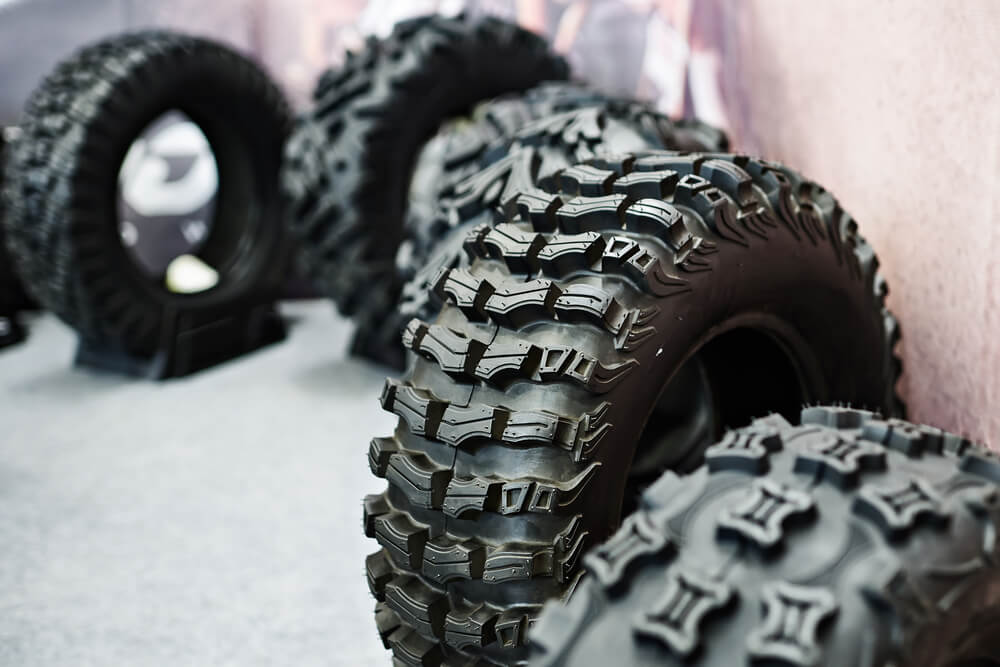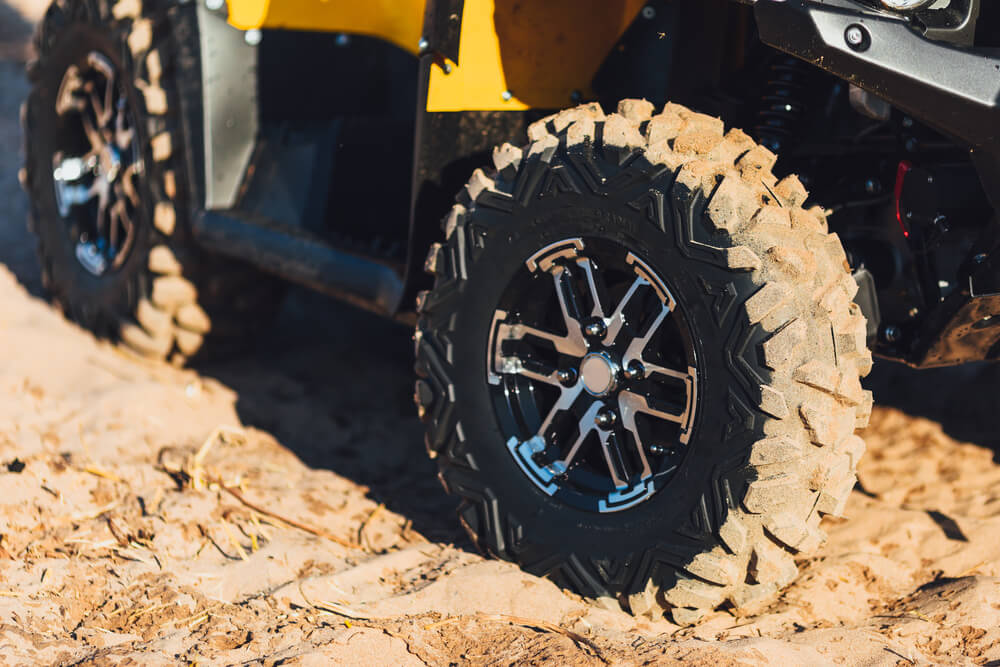All-terrain vehicle (ATV) tires are designed to withstand a variety of environments, making them a crucial component of your off-road adventures.
Understanding how long do ATV tires last is essential for ensuring optimal performance and safety while riding.
On average, ATV tires can last between 3 to 5 years or 6,000 to 8,000 miles, depending on factors such as the type of terrain, frequency of use, and proper maintenance.
ATV tire longevity is greatly influenced by how well you care for them and the conditions under which they are used. Factors to consider include the quality of the tires, the type of trails you ride on, air pressure, and your riding style.
Regularly checking the tire tread depth and inspecting for signs of wear and tear is crucial for knowing when it is time to replace your tires.
In order to get the most out of your ATV tires, it is essential to monitor their condition and be prepared to replace them when necessary.
Doing so ensures your safety and enhances your off-road experience.
Key Takeaways
- ATV tires typically last 3 to 5 years, or 6,000 to 8,000 miles, depending on various factors.
- Proper maintenance and monitoring tire condition are crucial for optimizing tire lifespan and safety.
- Replace ATV tires when signs of wear and tear are evident to maintain peak performance.
How Long Do ATV Tires Last?

ATV tires play a crucial role in your vehicle’s performance and durability.
In this section, we’ll discuss the components of an ATV tire and how variations based on type and usage can influence their lifespan.
Components of an ATV Tire
ATV tires consist of various parts that work together to provide traction, stability, and a comfortable ride. These components include:
- Tread: The outer layer of the tire, designed with specific patterns to grip different terrains effectively.
- Sidewall: The side portion of the tire, which provides lateral stability and protects the tire from punctures.
- Bead: The inner edge that connects the tire to the rim, ensuring a tight seal and keeping the tire in place.
- Carcass: The internal structure of the tire, usually composed of layers of fabric or steel, which determines the tire’s overall strength and flexibility.
By maintaining these components and choosing the right tires for your riding conditions, you can help prolong their lifespan and optimize your ATV’s performance.
Variations Based on Type and Usage
The lifespan of ATV tires can vary significantly based on their type and usage. Some factors that influence tire durability include:
- Terrain: Riding on harsh, rocky terrains can cause more wear and tear than riding on soft, sandy surfaces. Choosing tires specifically designed for the terrain you frequent can help extend their life.
- Tire Design: Different tires have unique tread patterns, rubber compounds, and carcass constructions, which can affect their wear rate. Selecting the right tire design for your riding style and conditions is essential for maximizing their lifespan.
- Riding Habits: Aggressive riding and frequent high-speed maneuvers can shorten tire life. Adopting a more conservative riding style can help prolong the life of your tires.
- Maintenance: Proper tire maintenance, such as maintaining the correct inflation pressure and regularly inspecting for damage or wear, can significantly impact how long your ATV tires last.
In general, ATV tires can last anywhere from a few hundred to 5,000 miles or more, depending on the factors listed above.
With proper care and attention, you can ensure that your ATV tires serve you well for years to come.
Factors Affecting ATV Tire Lifespan

There are several factors that can impact the lifespan of your ATV tires. In this section, we will discuss three main factors: tire material, terrain and riding style, and maintenance and care.
Tire Material
The material of your ATV tires plays a crucial role in determining their longevity. A high-quality tire made of durable rubber compounds will typically last longer than a cheaper, lower-quality tire.
The construction and design of the tire also affect its lifespan, as reinforced sidewalls and tread patterns can make a significant difference in handling various types of terrain.
Terrain and Riding Style
Your choice of terrain and riding style can have a direct effect on how quickly your ATV tires wear out. Harsh terrains like rocky surfaces or muddy areas put more strain on the tires, shortening their life expectancy.
Likewise, aggressive riding styles with rapid acceleration, sharp turns, and heavy braking can also cause ATV tires to wear out faster. If you regularly ride on the road, your tires may last from 1-2 years, while riding mostly off-road can extend their life up to 5-10 years.
Maintenance and Care
Proper maintenance and care of your ATV tires can significantly increase their lifespan.
Some important maintenance practices include:
- Regularly checking and maintaining the appropriate PSI level to prevent uneven wear and improve overall performance
- Inspecting the tires for any noticeable damage or signs of wear before each ride
- Rotating the tires periodically to ensure even wear
- Storing your ATV in a cool, dry place to prevent dry rot
By paying attention to the factors affecting your ATV tire lifespan, such as the material, terrain, and riding style, and practicing proper maintenance and care, you can prolong the life of your tires and enjoy your off-road adventures for years to come.
Signs of Wear and Tear

Visual Indicators
One of the first things you should check on your ATV tires is their visual appearance. Look for punctures in the rubber, cracks in the sidewall, or between treads. Bald spots could be a sign that your tires are wearing unevenly, while worn or missing tread lugs can indicate a loss of traction.
If any of these issues are present, it’s time to consider replacing your tires.
Another important aspect to pay attention to is the tread depth. A decrease in tread depth can significantly impact the tire’s performance, especially on wet or icy surfaces.
Regularly measuring the tread depth will help you determine if your tires need replacing.
Performance Indicators
While visual indicators are crucial in assessing tire wear, you should also pay attention to your ATV’s performance during your ride.
If you notice that your ATV feels less stable, has reduced traction, or requires more distance to come to a complete stop, these may be signs that it’s time to replace your tires.
In addition to the abovementioned factors, be mindful of the tire’s age and usage. ATV tires typically last for about 3,000 to 6,000 miles or 5 to 10 years with regular usage and proper maintenance.
Regardless, keep in mind that riding a lot on the road could reduce tire lifespan to just 1-2 years.
When and How to Replace ATV Tires

Ideal Replacement Period
The lifespan of ATV tires depends on factors such as the type of terrain you ride on and how often you use your ATV. Generally, tires can last anywhere from 1 to 5 years or longer.
To ensure optimal performance and safety, regularly assess your tires for signs of wear or damage.
Choosing the Right Replacement Tires
When it’s time to replace your ATV tires, it’s essential to choose the right ones for your specific needs. Consider factors such as:
- Tire size: Make sure the new tires will fit on your ATV’s rims and provide adequate clearance for your vehicle.
- Tread pattern: Depending on your preferred riding terrain, choose a tread pattern that offers optimal traction and control. For example, mud tires are best suited for muddy conditions, while all-terrain tires provide better performance on various surfaces.
- Ply rating: A higher ply rating indicates stronger, more durable tires. Choose a ply rating based on your riding style and the type of terrain you usually encounter.
Replacing ATV Tires at Home
If you’re confident in your mechanical skills, you can replace ATV tires at home by following these steps:
- Remove the old tire: Loosen the lug nuts and deflate the tire by removing the valve cap and using a valve core extractor. Once deflated, use a bead breaker to separate the tire from the rim.
- Mount the new tire: Position the new tire on the rim and apply lubricant to the bead. Use tire irons to work the bead onto the rim, making sure it’s evenly seated.
- Inflate and check the tire: Inflate the new tire according to the manufacturer’s specifications, ensuring the bead is still properly seated. Once inflated, check for any leaks and reinstall the valve cap.
Remember to always follow the manufacturer’s guidelines when replacing your ATV tires to maintain optimal performance and safety.
Conclusion
In summary, ATV tires generally last between 3 to 5 years and cover a range of 6000 to 8000 miles.
Although terrain conditions and riding frequency play a major role in tire longevity, you can make a significant difference by maintaining proper tire care.
To prolong the lifespan of your ATV tires, keep them adequately inflated and inspect them for signs of wear or damage before each ride.
Additionally, proper storage when not in use and adhering to manufacturer’s guidelines will increase the overall performance and durability of your ATV tires.
Remember that the type of terrain you ride on and how often you venture off-road may have a significant impact on tire life. So, take this into consideration when scheduling maintenance checkups and planning ahead for tire replacements.
By doing so, you will ensure your ATV remains safe and reliable during your adventures.
Frequently Asked Questions
What factors affect ATV tire lifespan?
Several factors can affect the lifespan of your ATV tires. These include driving habits, road conditions, tire design, tire age, and the quality of the tires themselves.
Regular maintenance and proper inflation can also play a role in extending their lifespan. It is essential to be mindful of these factors and to drive responsibly to ensure a longer-lasting set of tires.
How many miles can you expect from ATV tires?
ATV tires typically last for about 3,000 to 6,000 miles or 5 to 10 years with regular usage and proper maintenance. However, this number can vary based on the factors mentioned in the previous question.
Always monitor your tires’ condition and follow maintenance best practices to maximize their lifespan.
What signs indicate it’s time for new ATV tires?
There are several signs that it might be time for new ATV tires. These include visibly worn tread, cracks in the sidewalls, frequent punctures or flats, and decreased performance or handling.
If you notice any of these signs, it may be a good idea to consider a tire replacement to ensure your safety and your ATV’s performance.
What are the best practices for maintaining ATV tire longevity?
To maintain your ATV tire longevity, always check and maintain the recommended tire pressure, perform visual inspections for wear and damage, rotate and balance the tires regularly, and replace them when necessary.
Additionally, avoid overloading your ATV and drive cautiously on difficult terrains to prevent excessive wear.
How does terrain impact ATV tire wear?
The terrain you ride on can significantly impact your ATV tire wear. Riding on rocky surfaces, loose gravel, and off-road trails can cause faster wear on your tires. On the other hand, riding on smooth, even surfaces may result in less wear and a longer tire lifespan.
It is essential to choose the appropriate tire type for the terrain you will be riding on to prolong your tires’ life.
How are tire ages marked on ATV tires?
ATV tire ages can be identified by looking at the date code, which is usually a four-digit number located on the sidewall of the tire. The first two digits represent the week, and the last two digits represent the year the tire was manufactured.
For example, a tire with the date code “3121” was produced in the 31st week of 2021. It is crucial to keep track of your tire’s age and replace them when they become too old to maintain optimal performance and safety.














